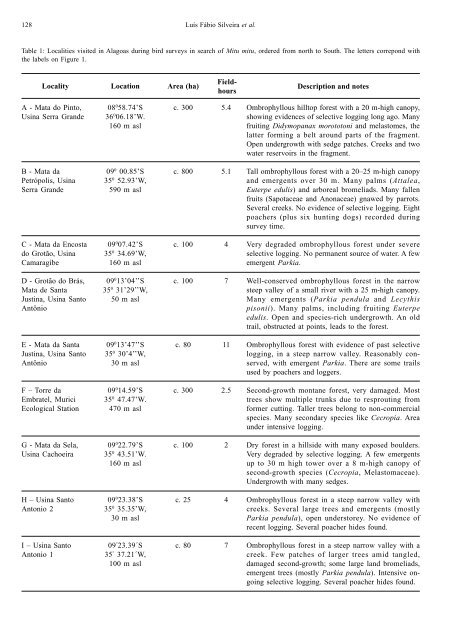Taxonomy, history, and status of Alagoas Curassow Mitu mitu ...
Taxonomy, history, and status of Alagoas Curassow Mitu mitu ...
Taxonomy, history, and status of Alagoas Curassow Mitu mitu ...
You also want an ePaper? Increase the reach of your titles
YUMPU automatically turns print PDFs into web optimized ePapers that Google loves.
128 Luís Fábio Silveira et al.<br />
Table 1: Localities visited in <strong>Alagoas</strong> during bird surveys in search <strong>of</strong> <strong>Mitu</strong> <strong>mitu</strong>, ordered from north to South. The letters correpond with<br />
the labels on Figure 1.<br />
Field-<br />
Locality Location<br />
Area (ha)<br />
Description <strong>and</strong> notes<br />
hours<br />
A - Mata do Pinto,<br />
Usina Serra Gr<strong>and</strong>e<br />
B - Mata da<br />
Petrópolis, Usina<br />
Serra Gr<strong>and</strong>e<br />
C - Mata da Encosta<br />
do Grotão, Usina<br />
Camaragibe<br />
D - Grotão do Brás,<br />
Mata de Santa<br />
Justina, Usina Santo<br />
Antônio<br />
E - Mata da Santa<br />
Justina, Usina Santo<br />
Antônio<br />
F – Torre da<br />
Embratel, Murici<br />
Ecological Station<br />
G - Mata da Sela,<br />
Usina Cachoeira<br />
H – Usina Santo<br />
Antonio 2<br />
I – Usina Santo<br />
Antonio 1<br />
08 0 58.74’S<br />
36 0 06.18’W.<br />
160 m asl<br />
09 0 00.85’S<br />
35 0 52.93’W,<br />
590 m asl<br />
09 0 07.42’S<br />
35 0 34.69’W,<br />
160 m asl<br />
09 0 13’04’’S<br />
35 0 31’29’’W,<br />
50 m asl<br />
09 0 13’47’’S<br />
35 0 30’4’’W,<br />
30 m asl<br />
09 0 14.59’S<br />
35 0 47.47’W.<br />
470 m asl<br />
09 0 22.79’S<br />
35 0 43.51’W.<br />
160 m asl<br />
09 0 23.38’S<br />
35 0 35.35’W,<br />
30 m asl<br />
09 ° 23.39´S<br />
35 ° 37.21´W,<br />
100 m asl<br />
c. 300<br />
c. 800<br />
c. 100<br />
c. 100<br />
c. 80<br />
c. 300<br />
c. 100<br />
c. 25<br />
c. 80<br />
5.4<br />
5.1<br />
4<br />
7<br />
11<br />
2.5<br />
2<br />
4<br />
7<br />
Ombrophyllous hilltop forest with a 20 m-high canopy,<br />
showing evidences <strong>of</strong> selective logging long ago. Many<br />
fruiting Didymopanax morototoni <strong>and</strong> melastomes, the<br />
latter forming a belt around parts <strong>of</strong> the fragment.<br />
Open undergrowth with sedge patches. Creeks <strong>and</strong> two<br />
water reservoirs in the fragment.<br />
Tall ombrophyllous forest with a 20–25 m-high canopy<br />
<strong>and</strong> emergents over 30 m. Many palms (Attalea,<br />
Euterpe edulis) <strong>and</strong> arboreal bromeliads. Many fallen<br />
fruits (Sapotaceae <strong>and</strong> Anonaceae) gnawed by parrots.<br />
Several creeks. No evidence <strong>of</strong> selective logging. Eight<br />
poachers (plus six hunting dogs) recorded during<br />
survey time.<br />
Very degraded ombrophyllous forest under severe<br />
selective logging. No permanent source <strong>of</strong> water. A few<br />
emergent Parkia.<br />
Well-conserved ombrophyllous forest in the narrow<br />
steep valley <strong>of</strong> a small river with a 25 m-high canopy.<br />
Many emergents (Parkia pendula <strong>and</strong> Lecythis<br />
pisonii). Many palms, including fruiting Euterpe<br />
edulis. Open <strong>and</strong> species-rich undergrowth. An old<br />
trail, obstructed at points, leads to the forest.<br />
Ombrophyllous forest with evidence <strong>of</strong> past selective<br />
logging, in a steep narrow valley. Reasonably conserved,<br />
with emergent Parkia. There are some trails<br />
used by poachers <strong>and</strong> loggers.<br />
Second-growth montane forest, very damaged. Most<br />
trees show multiple trunks due to resprouting from<br />
former cutting. Taller trees belong to non-commercial<br />
species. Many secondary species like Cecropia. Area<br />
under intensive logging.<br />
Dry forest in a hillside with many exposed boulders.<br />
Very degraded by selective logging. A few emergents<br />
up to 30 m high tower over a 8 m-high canopy <strong>of</strong><br />
second-growth species (Cecropia, Melastomaceae).<br />
Undergrowth with many sedges.<br />
Ombrophyllous forest in a steep narrow valley with<br />
creeks. Several large trees <strong>and</strong> emergents (mostly<br />
Parkia pendula), open understorey. No evidence <strong>of</strong><br />
recent logging. Several poacher hides found.<br />
Ombrophyllous forest in a steep narrow valley with a<br />
creek. Few patches <strong>of</strong> larger trees amid tangled,<br />
damaged second-growth; some large l<strong>and</strong> bromeliads,<br />
emergent trees (mostly Parkia pendula). Intensive ongoing<br />
selective logging. Several poacher hides found.

















